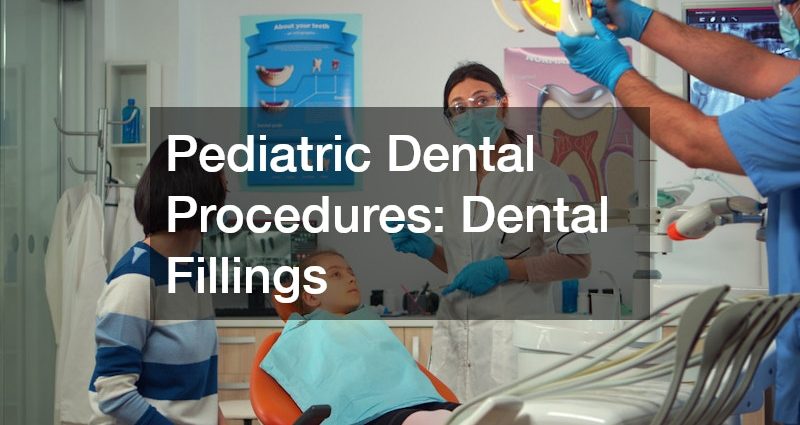
Dental health is crucial at every stage of life, and it’s especially important for children. Pediatric dental procedures are designed to protect young teeth and promote long-term oral health. Among these procedures, dental fillings play a vital role in preventing tooth decay, maintaining proper function, and supporting healthy growth. This article explores the essentials of pediatric dental fillings, including what they are, how they are applied, when they are necessary, and how to care for teeth afterward.
What Are Pediatric Dental Fillings?
A dental filling is a treatment used to restore a tooth damaged by decay. In children, fillings help repair cavities, prevent further decay, and maintain proper tooth structure.
Pediatric dental fillings are tailored to a child’s developing teeth, ensuring both functionality and comfort.
Types of Fillings Used in Children
Dentists use several types of fillings for pediatric patients, including:
-
Composite resin fillings, which are tooth-colored and blend naturally with existing teeth.
-
Glass ionomer fillings, which release fluoride to help protect against further decay.
-
Amalgam fillings, made from a durable metal alloy, though less commonly used today due to aesthetic concerns.
Benefits of Dental Fillings for Children
Dental fillings provide multiple benefits for children. They restore the function of damaged teeth, prevent the progression of cavities, reduce sensitivity and pain, and protect the overall alignment of teeth. Fillings also help children maintain proper chewing and speaking abilities.
Common Materials for Pediatric Fillings
The materials chosen for pediatric fillings are selected for safety, durability, and compatibility with developing teeth. Composite resins and glass ionomer materials are favored because they are gentle on enamel and support natural tooth growth.
Differences Between Pediatric and Adult Fillings
Pediatric fillings differ from adult fillings in terms of size, material, and application technique. Children’s teeth are still developing, and their dental enamel is thinner, so pediatric dentists often use materials that are less invasive, more protective, and easier to apply in a shorter procedure to reduce discomfort.
How Are Dental Fillings Applied to Children?
Initial Consultation and Assessment
The process begins with a thorough examination. The dentist assesses the severity of tooth decay, examines dental X-rays if necessary, and discusses treatment options with parents. This consultation helps determine the most appropriate filling type and method.
Steps in the Filling Procedure
The procedure typically involves:
-
Cleaning and preparing the cavity.
-
Removing decayed tissue.
-
Applying the filling material.
-
Shaping and polishing the filling to match the tooth’s natural form.
Most procedures are completed in a single visit, allowing children to return to their normal routine quickly.
Use of Anesthesia in Pediatric Fillings
Local anesthesia is often used to ensure the procedure is painless. For anxious or younger children, dentists may also use mild sedation techniques or distraction methods to create a calm environment.
Post-Filling Care for Children
After the filling, children may experience minor sensitivity for a short period. Dentists provide guidance on proper brushing, flossing, and avoiding certain foods to ensure the filling sets properly and lasts.
Managing Anxiety and Pain During the Procedure
Pediatric dentists are trained to reduce anxiety and discomfort using child-friendly communication, gentle techniques, and supportive tools. Creating a positive dental experience helps children feel comfortable during future visits.
When Is a Dental Filling Necessary for a Child?
Signs that Indicate the Need for Fillings
Common signs that a child may need a dental filling include tooth pain, sensitivity to hot or cold, visible holes or discoloration in the teeth, and difficulty chewing.
Risks of Untreated Cavities in Children
Untreated cavities can lead to infection, tooth loss, misalignment, and pain. Early intervention with dental fillings prevents these complications and supports overall oral development.
Timing for Dental Filling Procedures
Pediatric dentists recommend addressing cavities as soon as they are detected. Prompt treatment minimizes discomfort and protects surrounding teeth from decay.
Evaluating the Severity of Tooth Decay
The dentist evaluates the depth and extent of decay to determine whether a simple filling is sufficient or if more extensive treatment is required. X-rays and clinical examination are crucial in this assessment.
Regular Dental Check-Ups Importance
Routine dental visits allow for early detection of cavities, proper monitoring of existing fillings, and reinforcement of healthy dental habits. These check-ups are essential for maintaining a child’s oral health.
How to Care for Teeth After Fillings
Daily Oral Hygiene Practices
Encouraging children to brush twice daily with fluoride toothpaste and floss regularly is essential to maintain healthy teeth and prolong the life of dental fillings.
Foods to Avoid with New Fillings
Sticky, sugary, and hard foods should be limited immediately after a filling to prevent damage and allow the tooth to settle. Over time, balanced nutrition supports overall oral health.
Recognizing Problems with Fillings
Parents should watch for signs of a problem, such as persistent pain, sharp edges, or discoloration. Prompt dental visits ensure early intervention if issues arise.
Importance of Dental Appointments
Follow-up appointments allow the dentist to monitor fillings, address new cavities, and provide ongoing guidance for oral care.
Encouraging Lifelong Dental Health Habits
Teaching children proper brushing, flossing, and dietary habits fosters lifelong dental health. Positive experiences with dental procedures like fillings help children remain comfortable and proactive about oral care.
Dental fillings are a cornerstone of pediatric dentistry. They prevent the progression of cavities, restore tooth function, and support a child’s overall oral health. With proper care, fillings can last for years, contributing to healthy smiles and positive dental experiences. By understanding the purpose, procedure, and aftercare of pediatric dental fillings, parents can ensure their children receive the protection and guidance necessary for lifelong dental health.


